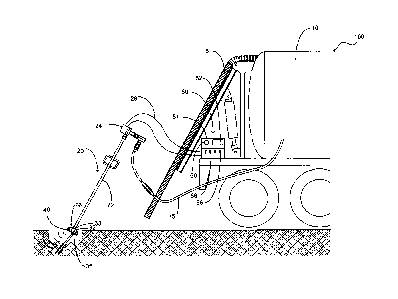Some of the information on this Web page has been provided by external sources. The Government of Canada is not responsible for the accuracy, reliability or currency of the information supplied by external sources. Users wishing to rely upon this information should consult directly with the source of the information. Content provided by external sources is not subject to official languages, privacy and accessibility requirements.
Any discrepancies in the text and image of the Claims and Abstract are due to differing posting times. Text of the Claims and Abstract are posted:
| (12) Patent Application: | (11) CA 3043826 |
|---|---|
| (54) English Title: | HYDROVAC EXCAVATION SYSTEM HAVING OBJECT DETECTION |
| (54) French Title: | SYSTEME D`EXCAVATION HYDRAULIQUE AVEC DETECTION D`OBJETS |
| Status: | Examination |
| (51) International Patent Classification (IPC): |
|
|---|---|
| (72) Inventors : |
|
| (73) Owners : |
|
| (71) Applicants : |
|
| (74) Agent: | RICHARD D. OKIMAWOKIMAW, RICHARD D. |
| (74) Associate agent: | |
| (45) Issued: | |
| (22) Filed Date: | 2019-05-21 |
| (41) Open to Public Inspection: | 2020-11-17 |
| Examination requested: | 2024-04-22 |
| Availability of licence: | N/A |
| Dedicated to the Public: | N/A |
| (25) Language of filing: | English |
| Patent Cooperation Treaty (PCT): | No |
|---|
| (30) Application Priority Data: | ||||||
|---|---|---|---|---|---|---|
|
An excavation system that is configured to utilize water pressure and
vacuum to provide removal of terrain from an area wherein the excavation
system
is further configured to provide detection and alert of subterranean objects
in the
excavation area. The excavation system includes a digging wand that is
operably
coupled to a water source. The digging wand includes a plurality of water jets
that
are configured to emit water. The digging wand further includes in the nozzle
thereof a plurality of detection transceivers. The detection transceivers are
configured to provide detection of subterranean objects proximate the nozzle
of the
digging wand during the excavation process. The controller of the present
invention
includes a screen that provides image data of the area proximate the nozzle.
The
controller further provides at least two operational modes wherein one of the
operational modes provides reduction of water pressure upon detection of a
subterranean object.
Note: Claims are shown in the official language in which they were submitted.
Note: Descriptions are shown in the official language in which they were submitted.

2024-08-01:As part of the Next Generation Patents (NGP) transition, the Canadian Patents Database (CPD) now contains a more detailed Event History, which replicates the Event Log of our new back-office solution.
Please note that "Inactive:" events refers to events no longer in use in our new back-office solution.
For a clearer understanding of the status of the application/patent presented on this page, the site Disclaimer , as well as the definitions for Patent , Event History , Maintenance Fee and Payment History should be consulted.
| Description | Date |
|---|---|
| Letter Sent | 2024-06-19 |
| Request for Examination Requirements Determined Compliant | 2024-04-22 |
| All Requirements for Examination Determined Compliant | 2024-04-22 |
| Request for Examination Received | 2024-04-22 |
| Inactive: Office letter | 2024-03-28 |
| Inactive: Office letter | 2024-03-28 |
| Application Published (Open to Public Inspection) | 2020-11-17 |
| Inactive: Cover page published | 2020-11-16 |
| Common Representative Appointed | 2019-10-30 |
| Common Representative Appointed | 2019-10-30 |
| Inactive: First IPC assigned | 2019-06-12 |
| Inactive: IPC assigned | 2019-06-12 |
| Inactive: Filing certificate - No RFE (bilingual) | 2019-06-07 |
| Filing Requirements Determined Compliant | 2019-06-07 |
| Inactive: Applicant deleted | 2019-06-04 |
| Inactive: IPC assigned | 2019-05-28 |
| Inactive: IPC assigned | 2019-05-28 |
| Inactive: IPC assigned | 2019-05-28 |
| Application Received - Regular National | 2019-05-24 |
| Small Entity Declaration Determined Compliant | 2019-05-21 |
There is no abandonment history.
The last payment was received on
Note : If the full payment has not been received on or before the date indicated, a further fee may be required which may be one of the following
Please refer to the CIPO Patent Fees web page to see all current fee amounts.
| Fee Type | Anniversary Year | Due Date | Paid Date |
|---|---|---|---|
| Application fee - small | 2019-05-21 | ||
| MF (application, 2nd anniv.) - small | 02 | 2021-05-21 | 2021-04-09 |
| MF (application, 3rd anniv.) - small | 03 | 2022-05-24 | 2022-04-20 |
| MF (application, 4th anniv.) - small | 04 | 2023-05-23 | 2023-05-18 |
| MF (application, 5th anniv.) - small | 05 | 2024-05-21 | 2024-04-22 |
| Request for examination - small | 2024-05-21 | 2024-04-22 | |
| MF (application, 6th anniv.) - small | 06 | 2025-05-21 |
Note: Records showing the ownership history in alphabetical order.
| Current Owners on Record |
|---|
| WILLIAM AUCLAIR |
| Past Owners on Record |
|---|
| None |